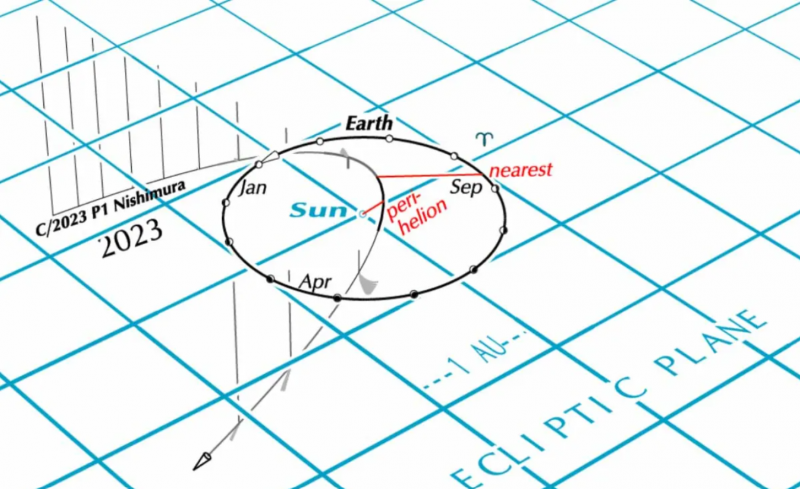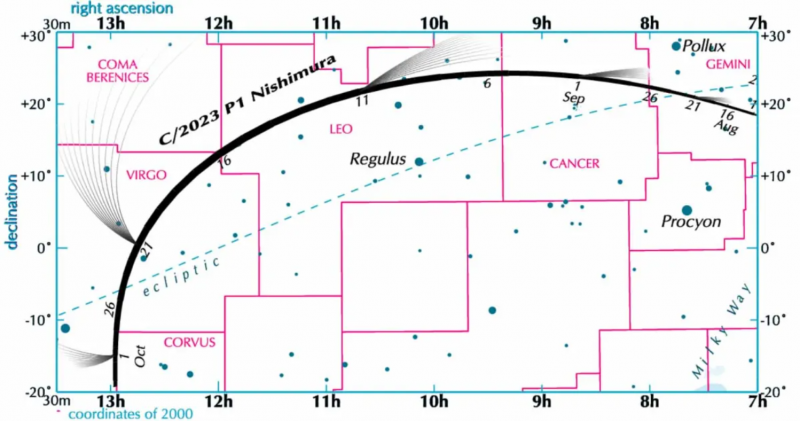Nishimura and the Sigma-Hydrid meteors
Comet C/2023 P1 (Nishimura) burst into our consciousness in August of 2023. It never got as bright as some hoped, but it still made a glorious target for astrophotographers. But is there still a chance to see parts of Comet Nishimura? Yes, only not as the comet itself, but instead as the dust it left behind burns up in our atmosphere. Astronomers think Nishimura may be the parent comet of an annual meteor shower known as the Sigma-Hydrids. This minor annual shower is active each year between December 9 and 12. Scientists will be closely monitoring the shower this year to see if there’s an uptick in meteors. And it might be worth it for us to go out and look, too!
So, if Nishimura is indeed related to the Sigma-Hydrids, then the comet might have “refilled” its path with icy comet particles. While this is normally a very quiet shower, it might be more active this year.
The video below is from December 2022, taken in the Caribbean. It’s a Sigma-Hydrid meteor, a possible Nishimura-related meteor!
Videos of Nishimura
However, professional observatories that peer at the sun have caught the comet in their images. You’ll find some amazing video of the comet by the sun on September 17, toward the end of the video above, or in the tweet below.
Comet Nishimura – that great icy ball moving through space, which so many have captured on film – was closest to Earth on September 12. It was then closest to the sun (perihelion) on September 17.
Meanwhile, the comet is also expected to reappear in our dawn skies toward the end of 2023. But by then it’ll be too distant, and too dim, to view, as it sweeps farther away. But we may get to see some of what it left behind in December, however, with the Sigma Hydrid meteor shower! Read on to learn more about it.
Wondering what happened to comet Nishimura? It's still quite happily sunbathing in the field of view of our @USNRL HI-1 camera on @NASA STEREO-A! Lots of great ion tail / solar wind interaction happening! ????
Download the full-res movie here: https://t.co/gkv2HCpIUS pic.twitter.com/xzHvdgBfjt
— Karl Battams (@SungrazerComets) September 26, 2023
The story of comet Nishimura
Hideo Nishimura of Kakegawa, Japan, was photographing the night sky on August 11 and 12, 2023, when he captured a new comet that now bears his name: comet C/2023 P1 (Nishimura). In fact, the comet was hiding in the sun’s glare before Nishimura picked it up in his images.
It continued to brighten as it closed in on the sun (perihelion was September 17). Later, after passing closest to Earth on September 12, it emerged low in the evening sky. Some saw it with binoculars in the western evening twilight. Now, it’s too close to the sun for observing, and it will stay that way until it’s far away and too dim to see again.

A local comet
Moreover, on September 1, 2023, NASA/JPL made new orbital calculations that indicated that comet Nishimura orbits the sun every 435 years, which suggests this is a “local comet” from our solar system and not an interstellar comet.
Closest approach to Earth occurred on September 12, 2023, when the comet passed 78 million miles (125 million km) from Earth.
Perihelion – or closest approach to the sun – was on September 17, 2023, at 27 million miles (43 million km) from our star.
In fact, during perihelion, comet Nishimura passed closer to the sun than Mercury’s orbit.


Sightings of comet Nishimura
Comet Nishimura (C/2023 P1) on Sept 5, 2023. For this single shot I used my A7s and a 135mm lens.
Nishimura is a new comet that was discovered on August 11, 2023. It's expected to brighten to a magnitude of 1.8. Its closest approach to us will be on Sep 12 and its perihelion on… pic.twitter.com/BXhDo0IOpq
— Dr. Sebastian Voltmer (@SeVoSpace) September 6, 2023
comet C/2023 P1 (Nishimura) from Belfast, N Ireland at around 5am on 4th Sept 2023. Cropped from a 100mm image – stack of 50 x 3secs at ISO800. (Some problems with stacking caused a halo above neighbour's roof!) @martinastro2005 pic.twitter.com/jCuuZa3egN
— Philip?EcotrakNI (@EcotrakNI) September 4, 2023
comet C/2023 P1 (Nishimura): Such a strong solar wind. The disconnection event on September 2nd – the spectacular development in a 20-minute animation (RASA 11 QHY600) and 4x80sec red Michael Jäger pic.twitter.com/qf43YqhBbl
— Michael Jäger (@Komet123Jager) September 2, 2023
Bottom line: Comet Nishimura may be the parent comet to the Signma-Hydrid meteor shower, which peaks between December 9 and 12. Will the shower be more active this year? The only way to know is to go look!
See photos of comet Nishimura from the EarthSky community
Via:
The post Did Nishimura give a boost to the Sigma-Hydrid meteors? first appeared on EarthSky.
0 Commentaires